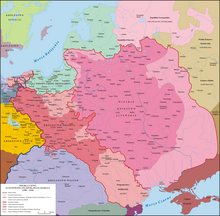Our website is made possible by displaying online advertisements to our visitors.
Please consider supporting us by disabling your ad blocker.
Natural border

A natural border is a border between states or their subdivisions which is concomitant with natural formations such as rivers or mountain ranges. The "doctrine of natural boundaries" developed in Western culture in the 18th century being based upon the "natural" ideas of Jean-Jacques Rousseau and developing concepts of nationalism.[1] The similar concept in China developed earlier from natural zones of control.[2]


Natural borders have historically been strategically useful because they are easily defended. Natural borders remain meaningful in modern warfare even though military technology and engineering have somewhat reduced their strategic value.
Expanding until natural borders are reached, and maintaining those borders once conquered, have been a major policy goal for a number of states. For example, the Roman Republic, and later, the Roman Empire expanded continuously until it reached certain natural borders: first the Alps, later the Rhine river, the Danube river and the Sahara desert. From the Middle Ages onwards until the 19th century, France sought to expand its borders towards the Alps, the Pyrenees, and the Rhine River.[3]
Natural borders can be a source of territorial disputes when they shift. One such example is the Rio Grande, which defines part of the border between the United States and Mexico, whose movement has led to multiple conflicts.
Natural borders are not to be confused with landscape borders, which are also geographical features that demarcate political boundaries. Although landscape borders, like natural borders, also take forms of forests, water bodies, and mountains, they are manmade instead of natural. Installing a landscape border, usually motivated by demarcating treaty-designated political boundaries, goes against nature by modifying the borderland's natural geography. For one, China's Song Dynasty built an extensive defensive forest in its northern border to thwart the nomadic Khitan people.[4]
- ^ Dikshit, Ramesh Dutta (1999). Political Geography: the Spatiality of Politics (3rd ed.). New Delhi: McGraw-Hill. p. 70. ISBN 978-0-07-463578-0.
- ^ See Wheatley, Paul (1971). The Pivot of the Four Quarters: a preliminary enquiry into the origins and character of the ancient Chinese city. Chicago: Aldine Publishing. pp. 170–173. ISBN 978-0-85224-174-5.
- ^ Carlton, J. H. Hayes (1916). A Political and Social History of Modern Europe, volume 1. New York: Macmillan. p. 119. OCLC 2435786.
- ^ Chen, Yuan Julian (July 2018). "FRONTIER, FORTIFICATION, AND FORESTATION: DEFENSIVE WOODLAND ON THE SONG–LIAO BORDER IN THE LONG ELEVENTH CENTURY". Journal of Chinese History. 2 (2): 313–334. doi:10.1017/jch.2018.7. ISSN 2059-1632.
Previous Page Next Page


